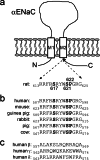Two adjacent phosphorylation sites in the C-terminus of the channel's α-subunit have opposing effects on epithelial sodium channel (ENaC) activity
- PMID: 35525869
- PMCID: PMC9192390
- DOI: 10.1007/s00424-022-02693-9
Two adjacent phosphorylation sites in the C-terminus of the channel's α-subunit have opposing effects on epithelial sodium channel (ENaC) activity
Erratum in
-
Correction to: Two adjacent phosphorylation sites in the C-terminus of the channel's α-subunit have opposing effects on epithelial sodium channel (ENaC) activity.Pflugers Arch. 2022 Sep;474(9):1037. doi: 10.1007/s00424-022-02717-4. Pflugers Arch. 2022. PMID: 35676334 Free PMC article. No abstract available.
Abstract
How phosphorylation of the epithelial sodium channel (ENaC) contributes to its regulation is incompletely understood. Previously, we demonstrated that in outside-out patches ENaC activation by serum- and glucocorticoid-inducible kinase isoform 1 (SGK1) was abolished by mutating a serine residue in a putative SGK1 consensus motif RXRXX(S/T) in the channel's α-subunit (S621 in rat). Interestingly, this serine residue is followed by a highly conserved proline residue rather than by a hydrophobic amino acid thought to be required for a functional SGK1 consensus motif according to in vitro data. This suggests that this serine residue is a potential phosphorylation site for the dual-specificity tyrosine phosphorylated and regulated kinase 2 (DYRK2), a prototypical proline-directed kinase. Its phosphorylation may prime a highly conserved preceding serine residue (S617 in rat) to be phosphorylated by glycogen synthase kinase 3 β (GSK3β). Therefore, we investigated the effect of DYRK2 on ENaC activity in outside-out patches of Xenopus laevis oocytes heterologously expressing rat ENaC. DYRK2 included in the pipette solution significantly increased ENaC activity. In contrast, GSK3β had an inhibitory effect. Replacing S621 in αENaC with alanine (S621A) abolished the effects of both kinases. A S617A mutation reduced the inhibitory effect of GKS3β but did not prevent ENaC activation by DYRK2. Our findings suggest that phosphorylation of S621 activates ENaC and primes S617 for subsequent phosphorylation by GSK3β resulting in channel inhibition. In proof-of-concept experiments, we demonstrated that DYRK2 can also stimulate ENaC currents in microdissected mouse distal nephron, whereas GSK3β inhibits the currents.
Keywords: Dual-specificity tyrosine phosphorylated and regulated kinase 2 (DYRK2); Epithelial sodium channel (ENaC); Glycogen synthase kinase 3 beta (GSK3β); Microdissected mouse distal nephron; Patch clamp; Serum- and glucocorticoid-induced kinase isoform 1 (SGK1); Xenopus laevis oocytes.
© 2022. The Author(s).
Conflict of interest statement
The authors declare no competing interests.
Figures







Similar articles
-
Acute activation of human epithelial sodium channel (ENaC) by serum and glucocorticoid inducible kinase 1 (SGK1) requires prior cleavage of the channel's γ-subunit at its proximal cleavage site.Pflugers Arch. 2025 Aug;477(8):1061-1074. doi: 10.1007/s00424-025-03099-z. Epub 2025 Jun 21. Pflugers Arch. 2025. PMID: 40542158 Free PMC article.
-
Protein kinase B alpha (PKBα) stimulates the epithelial sodium channel (ENaC) heterologously expressed in Xenopus laevis oocytes by two distinct mechanisms.Cell Physiol Biochem. 2010;26(6):913-24. doi: 10.1159/000324000. Epub 2011 Jan 4. Cell Physiol Biochem. 2010. PMID: 21220922
-
A novel pathway of epithelial sodium channel activation involves a serum- and glucocorticoid-inducible kinase consensus motif in the C terminus of the channel's alpha-subunit.J Biol Chem. 2004 Sep 10;279(37):38134-42. doi: 10.1074/jbc.M403260200. Epub 2004 Jul 1. J Biol Chem. 2004. PMID: 15234985
-
New insights into the role of serum- and glucocorticoid-inducible kinase SGK1 in the regulation of renal function and blood pressure.Curr Opin Nephrol Hypertens. 2005 Jan;14(1):59-66. doi: 10.1097/00041552-200501000-00010. Curr Opin Nephrol Hypertens. 2005. PMID: 15586017 Review.
-
Regulation of the epithelial Na+ channel by the mTORC2/SGK1 pathway.Nephrol Dial Transplant. 2016 Feb;31(2):200-5. doi: 10.1093/ndt/gfv270. Epub 2015 Jul 9. Nephrol Dial Transplant. 2016. PMID: 26163195 Free PMC article. Review.
Cited by
-
The Epithelial Sodium Channel-An Underestimated Drug Target.Int J Mol Sci. 2023 Apr 24;24(9):7775. doi: 10.3390/ijms24097775. Int J Mol Sci. 2023. PMID: 37175488 Free PMC article. Review.
-
Aldosterone-independent regulation of K + secretion in the distal nephron.Curr Opin Nephrol Hypertens. 2024 Sep 1;33(5):526-534. doi: 10.1097/MNH.0000000000001006. Epub 2024 Jun 18. Curr Opin Nephrol Hypertens. 2024. PMID: 38888034 Review.
-
SECS, drugs, and Rac1&Rho: regulation of EnNaC in vascular endothelial cells.Pflugers Arch. 2025 Jul;477(7):977-992. doi: 10.1007/s00424-025-03093-5. Epub 2025 May 22. Pflugers Arch. 2025. PMID: 40402207 Free PMC article.
-
Automated patch-clamp recordings for detecting activators and inhibitors of the epithelial sodium channel (ENaC).Pflugers Arch. 2025 Jun;477(6):857-872. doi: 10.1007/s00424-025-03087-3. Epub 2025 May 8. Pflugers Arch. 2025. PMID: 40335709 Free PMC article.
-
Acute activation of human epithelial sodium channel (ENaC) by serum and glucocorticoid inducible kinase 1 (SGK1) requires prior cleavage of the channel's γ-subunit at its proximal cleavage site.Pflugers Arch. 2025 Aug;477(8):1061-1074. doi: 10.1007/s00424-025-03099-z. Epub 2025 Jun 21. Pflugers Arch. 2025. PMID: 40542158 Free PMC article.
References
Publication types
MeSH terms
Substances
LinkOut - more resources
Full Text Sources
Molecular Biology Databases

